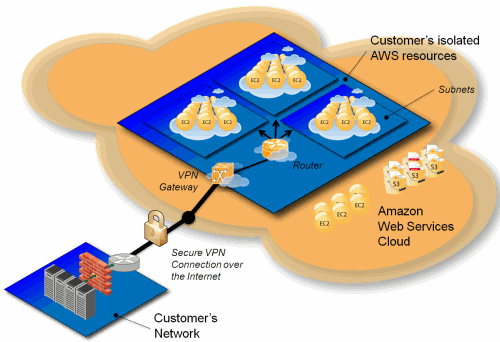Hybrid Clouds: are we there yet?
by Johan De Gelas on October 18, 2010 2:05 PM EST- Posted in
- IT Computing
Building a bridge between two datacenters is pretty easy and mature. In fact many of you do this on a daily basis: you make a VPN connection between your own network and a remote network. Site to site VPNs have been available for quite some time now. And that is exactly what Amazon offers with their VPC product.

Howie Xu, R&D Director from VMware, presented VMware’s vision concerning the future of networking. VMware virtual switch was the first step. The vswitch offered portgroups which allowed you to separate storage, console and VM networking from each other. A vswitch was always limited to one server, one host.
In vSphere 4.0, the distributed vSwitch was born. In 4.1 with VLANs and traffic shaping was introduced. Distributed switches can span several servers, making it easier to configure networking for a complete cluster instead of configuring vSwitches on different hosts.
The next step would be to creat a Distributed Virtual Network, a virtual networking chassis. This vChassis would be able to create a distributed network from layer 2 to 7 accross two or more datacenters.
Unfortunately, the presentation did not give any insight on how this will be accomplished.











26 Comments
View All Comments
chusteczka - Wednesday, October 20, 2010 - link
This author needs to submit his work to a proofreading editor before it gets published.akocsis - Wednesday, October 20, 2010 - link
There are absolutely no words about Microsoft's offering - Azure - in the article. Why do you think they are not in the game? Azure is a totally different approach, as you buy computing "blocks" (which are VMs in the background), not the VM's itself. You don't want to maintain VMs, you want computing capacity without the need of OS maintenance...Exelius - Wednesday, October 20, 2010 - link
Azure is not flexible enough for general purpose loads. Great if you're developing a .NET web app; not so much if you're trying to run an ActiveDirectory backup DC. It's nice to be able to ship a .vmdk across the internet to clone a server.JohanAnandtech - Friday, October 22, 2010 - link
Remember, we told you in the first lines that we would focus on Infrastructure as a Service. Azure is PaaS and is only natural that it does appear in an article about IaaS.billt9 - Thursday, October 21, 2010 - link
speaking solely from a personal computing viewpoint - unnecessary; expensive; insecure. The whole PC revolution was AWAY from central computers with dumb terminals.landerf - Wednesday, October 27, 2010 - link
A note on the negativity towards cloud computing. A lot of it ignores the situational benefits in favor of fear, fear of losing freedoms and being vulnerable to centralized security targets. I can understand that, as it may be a valid concern. Companies using clouds will inevitably force the tech on the general consumer in a more and more invasive way in the decades to come. Cloud computing certainly has it's uses, but I'd never want it to take over. Even in a future where we have absurd bandwidth and nil latencies the idea of centralization is always a bad one. With "clouds", power plants, or the forever proposed wireless electricity grid, you're always setting yourself up for failure. Decentralization and redundancy are by far the best solutions. Every neighborhood in the future should have it's own power plant, every person should have all of their personal data embedded in their body, only sharing what they want when they want. On mass identity theft would be obscure, fear over catastrophic accidents or attacks would be averted. At the end of the day, decentralization is always better, including with the backbones used to share data.